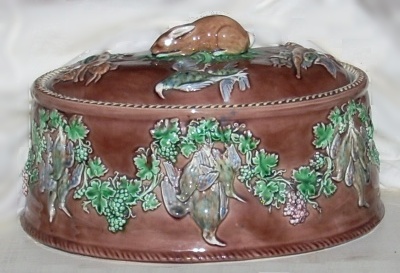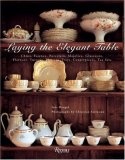-
History of:
- Resources about:
- More:
- Baby walkers
- Bakehouses
- Bed warmers
- Beer, ale mullers
- Besoms, broom-making
- Box, cabinet, and press beds
- Butter crocks, coolers
- Candle snuffers, tallow
- Clothes horses, airers
- Cooking on a peat fire
- Drying grounds
- Enamel cookware
- Fireplaces
- Irons for frills & ruffles
- Knitting sheaths, belts
- Laundry starch
- Log cabin beds
- Lye and chamber-lye
- Mangles
- Marseilles quilts
- Medieval beds
- Rag rugs
- Rushlights, dips & nips
- Straw mattresses
- Sugar cutters - nips & tongs
- Tablecloths
- Tinderboxes
- Washing bats and beetles
- Washing dollies
- List of all articles
Subscribe to RSS feed or get email updates.
Laying the Elegant Table: China, Faience, Porcelain, Majolica, Glassware, Flatware, Tureens, Platters, Trays, Centerpieces, Tea Sets
from Amazon.com
or Amazon UK
The scarcity ... in July, 1800, was so great that the consumption of flour for pastry was prohibited in the royal household, rice being used instead; the distillers left off malting, hackney coach fares were raised twenty-five per cent., and Wedgwood made dishes to represent pie-crust.
William Jesse, The Life of George Brummell, Esq.: Commonly Called Beau Brummell, 1844
Game pie dishes
Pie covered with ceramic wild game, not pastry
 Recipes for a good game pie, full
of venison, or hare, or pheasant, tell the cook to cover the meat with a pastry
pie crust. But ornate game pie dishes like the one in the photo allowed you to
make a pie with no crust. There was an
inner liner to hold the pie together, while the cover served instead of
a pastry lid.
Recipes for a good game pie, full
of venison, or hare, or pheasant, tell the cook to cover the meat with a pastry
pie crust. But ornate game pie dishes like the one in the photo allowed you to
make a pie with no crust. There was an
inner liner to hold the pie together, while the cover served instead of
a pastry lid.
Why? In the late 18th century there was a shortage of wheat in England, prices went up, and flour was expensive for much of the next half-century. Many households tried to economise on flour, some following the lead of the royal household by making pies without pie-crust. (See left-hand column.)
Obviously, poor people had different problems from those whose idea of economy was buying a new pie dish with a decorative ceramic cover, then filling it with an abundance of rich meat. Nevertheless, flour prices remained high, and for about a hundred years special dishes for making pies without pastry were manufactured by Josiah Wedgwood and others, after it was suggested to Wedgwood in 1786. One game pie dish was shown at the Great Exhibition in London in 1851.
The liner and the cover could both be made of pale beige pottery, called caneware because of its colour. The covers were also made in brightly coloured and glazed earthenware (majolica), in the style of 19th-century fish tureens, cheese dishes, and other serving dishes lavishly embellished with shiny models of flora and fauna.
The animals chosen to decorate game pie weren't always strictly game. These ducks look like farmyard creatures, not wild birds. Here the handle is a fox: associated with hunting, but not usually eaten.
The presence of the majolica game pie dish, draped with images of sumptuous game animals, at the dinner table suggested the host and hostess either owned vast tracts of property on which to hunt or had the high connections necessary to legally obtain these much-appreciated delicacies.
Jeffrey B. Snyder, Victorian Views of Nature Revealed in Majolica, c2002
Wedgwood, Josiah, & Sons, Etruria, near Newcastle-under-Lyme - Manufacturers...
Oval game pie, cane colour, ornamented...
Official Descriptive and Illustrated Catalogue: Great Exhibition oOfficial Descriptive and Illustrated Catalogue: Great Exhibition of the Works of Industry of All Nations, London 1851
 1 June 2008
1 June 2008
See also:
Tureens and poultry
You may like our new sister site Home Things Past where you'll find articles about antiques, vintage kitchen stuff, crafts, and other things to do with home life in the past. There's space for comments and discussion too. Please do take a look and add your thoughts. (Comments don't appear instantly.)
For sources please refer to the books page, and/or the excerpts quoted on the pages of this website, and note that many links lead to museum sites. Feel free to ask if you're looking for a specific reference - feedback is always welcome anyway. Unfortunately, it's not possible to help you with queries about prices or valuation.



